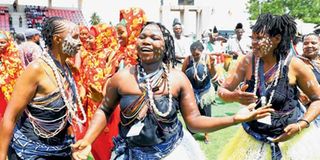Cultural celebration at JAMA FEST 2019

Scene from the 2019 Jama Fest in Dar es Salaam. PHOTO | MICHAEL MATEMANGA
It’s jubilation full throttle as East Africans celebrate cultural diversity in Tanzania.
In an event to revel at the different cultures from East Africa, member states convened in Dar es Salaam, Tanzania for the 4th edition of the East African Community Arts and Culture Festival, popularly known as Jumuiya ya Africa Mashariki Utamaduni Festival (JAMAFEST).
The event, which started this past Sunday, will come to an end tomorrow, September 28, 2019. The week-long celebrations aim to promote regional socio-cultural integration through arts and culture by providing a platform to showcase culture as a primary driver of regional integration.
Entertainment is in full swing as different activities are showcased to the public. From carnivals, art exhibitions, a symposium, live performances, films, literary works, a fashion show, traditional East African Foods, music and traditional games, the festival features everything that one could ask for.
Set at the National Stadium, in attendace on the first day were Tanzanian Vice President Samia Suluhu Hassan, Kenya’s Cabinet Secretary for Sports Amina Mohamed, and Tanzania’s minister of Information, Sports, Arts and Culture, Dr. Harrison Mwakyembe among other dignitaries.
Right from the start, the event promised to be one to remember as participating nations, including hosts Tanzania, Kenya, Uganda, Burundi, Rwanda and South Sudan all had representatives ready to provide maximum entertainment.
Addressing delegates and participants during the launch, Tanzania’s Vice President praised the event as a platform for marketing cultural and creative commodity outputs within the region and internationally.
“This iconic event not only aims at bringing together East Africa cultural practitioners, workers and administrators to celebrate the rich diversity of East African cultural heritage and creativity, but we also want to promote cultural tourism as well as conservation, safeguarding and development of cultural heritage within the EAC,” said the V-P.
With ‘Cultural Diversity: A Key Driver to Regional Integration, Economic Growth and Promotion of Tourism’ as the theme for the 2019 edition of Jama Fest, the audience were in for a truly remarkable performance.
Rwanda, Kenya and Uganda have all hosted the cultural event in past years. The first edition of the festival held once every two years took place in Rwanda in 2013, with Kenya hosting the 2015 edition - and Uganda the 2017 edition.
The idyllic set-up at the national stadium provided ample space for spectators to witness different cultural performances. Local residents showed up in thousands at the stadium were true African traditional dances were on display.
Even under the scotching Dar es Salaam sun, each group that took the stage put up a performance to remember as the audience cheered on in excitement. Lack of shade or special seats for spectators did little to dampen the mood of enthusiasm that kept building up as the festival progressed.
Clementine Chale, a Kurasini resident said she was enticed to attend the festival after watching television and seeing all the fun activities that were unfolding on the ground. “I personally didn’t know about the event until when I saw a live broadcast on television, which prompted me to come and witness for myself what was happening,” she said. She added that East Africa is blessed with cultural diversity. “I’ve seen different traditional dances from East Africa and I must say I’m very proud and happy.”
Chale was particularly moved by the dexterity of Burundi drummers. She also took particular notice of the unique Kenyan traditional dancers, not forgetting the top-notch display put up by Tanzanians. “I didn’t know we have such great traditional artistes in Tanzania,” she said.
Mary Wambua, a Kenyan entrepreneur who labored to attend the festival says it is a good platform to learn the different cultures from East Africa member States.
“This is not my first time in Tanzania, but this trip is more memorable because I’ve gotten to meet other East African entrepreneurs, on top of witnessing some great traditional dances,” she said.
“Seeing kids dancing traditional dances soothes my heart because it shows that we are passing on our African heritage to the next generation,” she added.
One of the highlight performances came from Peter Msechu, who in true African tradition took the stage and rendition some of the most iconic traditional songs from the archives. He started off by singing the popular song ‘Rangi ya Chungwa’ he followed this up with ‘Neema’ from DDC Mlimani Park. He didn’t stop there, amidst great excitement from the audience, especially those from Rwanda and Burundi who decided to get closer to the stage to have a face-full of the performance, Msechu went on to add a mix of FM Academia’s ‘Utamu wa Vanilla’ to the rendition of ‘Rangi ya Chungwa’ by Nyanyembez Jazz.
The artiste didn’t leave out Singeli, which is now a popular genre amongst local Tanzanians – a fitting mix at a festival which celebrates African traditional themes.
Another performance from a Bongo Flava artiste which took the festival by storm came from Diamond Platnumz. The Wasafi CEO performed on the second day of the festival.
His arrival sent pandemonium across the stadium as fans made a stampede to the stage to watch the ‘Kanyaga’ hitmaker bring his A-game.
Initially scheduled to perform for five minutes, Diamond extended that time to 20 minutes due to the sheer excitement and enthusiasm from the audience who wanted more from the star.
Even though Diamond is currently making rounds around the country on his Wasafi tour, being a part of Jama Fest christened the event as a true pioneer of celebrating East Africa’s rich cultural diversity.




